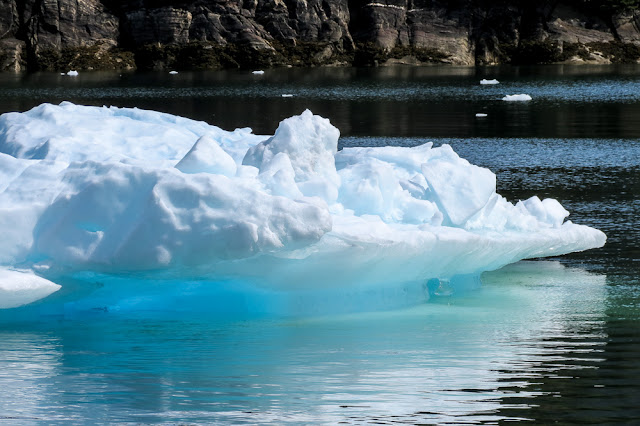June 1 Icebergs in LeConte Bay
It is easy to spot the entrance to LeConte Bay. Be on the lookout for a fleet of icebergs grounded on the entry reef extending from the north shore. In some previous years we have seen huge armadas of bergs
drifting along Frederick Sound just outside Petersburg Harbor, but not this
year. No, today we had to travel 23nm southeast of town to view the calved
icebergs at the source.
We wove our way through floating bergs, keeping a
cautious distance from the larger ones since the bulk of their mass is unseen,
hidden underwater by the cloudy celadon-colored, glacial-melt water. Several
smaller bergs rolled over, unstable as the warmer seawater melted part of the
underwater mass resulting in a top-heavy condition.
The bergs grew more closely packed as we traveled farther up
the bay, finally stopping us just before the last s-bend. We didn’t make it all
of the way up to the face of LeConte glacier, never even saw it. It didn't matter, we thoroughly
enjoyed our morning iceberg cruise in LeConte Bay anyway.
 |
| Photo: Nobeltec Navigation display - the red arrowed line shows our route, the green boat figure represents the boat's location. |
 |
| Photo: dots on the radar screen represent the largest icebergs in a one-mile range of the boat. The curving solid masses whow the shoreline. |
Factoids from the 2015 Petersburg Viking Visitor Guide:
*-LeConte Bay and LeConte Glacier were named in 1887 for Joseph LeConte, professor of geology at the University of California.
*-LeConte Glacier… is perhaps the most studied glacier in the world. For 23 consecutive years student teams from PHS have surveyed the face and tracked the glacier’s movement.
*-The snowfield above the glacier runs up the Stikine River valley.It has the distinction of being the southernmost active tidewater glacier in North America.
*-The spring of 1998 saw the waters of Frederick Sound choked with bergs after a half-mile of ice from the glacier calved into the bay.
*-LeConte Glacier (is like) a tube of toothpaste. The more snow pack and weight that compresses the ice further up the valley, the more ice advances into the bay.
*-For the past decade, the face of the glacier has remained stable… within an average distance of 92 yards of its 1999 position. It’s tendency is to move forward with the spring melts, retreating again in the fall. LeConte has retreated 1.2 miles since 1991.
*-In some places the ice has been measured at 4400 feet thick.
*-At the terminus, about 200 feet of ice rise above sea level, and 800 feet are hidden below the waterline of the bay.








No comments:
Post a Comment
I enjoy reading your comments, so please leave a friendly message. Comments are moderated so it may take a while for your note to appear.